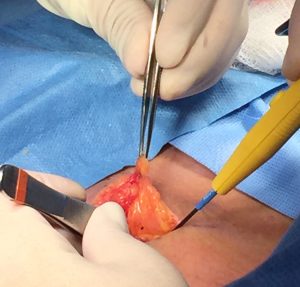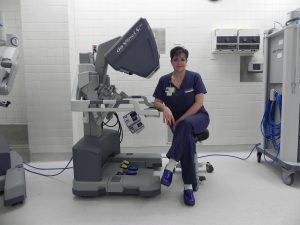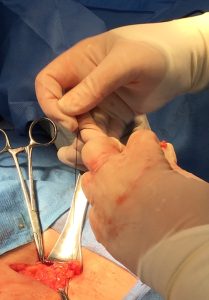Hernia Repair Techniques
As a true hernia specialist, we are experienced in every type of surgical technique for your hernia repair. During your consultation, we will tailor our operative recommendations to be specific to your needs . No single technique is superior to another.
 Open hernia repair is tried and true. It has been performed for over a century and there are close to a hundred different techniques that can be employed. Most of our incisions are only 4 cm (under 2 inches).
Open hernia repair is tried and true. It has been performed for over a century and there are close to a hundred different techniques that can be employed. Most of our incisions are only 4 cm (under 2 inches).
The gold standard open repair is with mesh, with the Lichtenstein technique being the most common with the best outcomes. There are a variety of mesh products, which can be implanted with varying characteristics for recurrence and chronic pain. Since we are among the premier Hernia Centers in the world, we have access to mesh products not yet available commercially. We always choose the best mesh for each patient’s needs to minimize risk and maximize outcome.
We also offer non-mesh repairs, which may be more appropriate for certain subgroups of patients, especially thin young women with low risk for hernia recurrence.
Laparoscopic hernia surgery offers several benefits over open repair. This includes lower risk for infection, better longterm outcomes, and shorter recovery time (for inguinal hernias only). These benefits are only true if the operation is performed by a laparoscopic specialist with many years of experience.
Dr. Towfigh has been training residents and fellows in minimally invasive laparoscopic hernia surgery since 2002. Her technique is one of low pain and excellent outcome alongside great cosmesis. That said, we know that laparoscopic surgery is not necessarily the best option for every patient. Dr. Towfigh will discuss this in detail during your consultation so that you can make the best informed decision to achieve your desired outcome.
 Robotic-assisted surgery is basically laparoscopic surgery, with some additional benefits. For hernia surgery, robotic-assistance, using the daVinci robot, may be able to provide a wider range of laparoscopic repairs and opportunities than would otherwise be able to be performed without the robot.
Dr. Towfigh is on the forefront of robotic surgery and among its most active users for hernia surgery. She is applying robotic technology to operations that were not possibly performed laparoscopically or with minimally invasive techniques. These include closures of diastasis recti and non-mesh inguinal hernia repairs.
Similar to laparoscopy, robotic surgery is not necessarily the best option for every patient. Also, similar to laparoscopic surgery, it is best performed by surgeons with a lot of experience, as it has its own risks. Dr. Towfigh teaches and proctors residents, fellows, and practicing surgeons for robotic surgery of all types.
Preview of Dr. Towfigh performing robotic mesh removal and incisional hernia repair.
Robotic-assisted surgery is basically laparoscopic surgery, with some additional benefits. For hernia surgery, robotic-assistance, using the daVinci robot, may be able to provide a wider range of laparoscopic repairs and opportunities than would otherwise be able to be performed without the robot.
Dr. Towfigh is on the forefront of robotic surgery and among its most active users for hernia surgery. She is applying robotic technology to operations that were not possibly performed laparoscopically or with minimally invasive techniques. These include closures of diastasis recti and non-mesh inguinal hernia repairs.
Similar to laparoscopy, robotic surgery is not necessarily the best option for every patient. Also, similar to laparoscopic surgery, it is best performed by surgeons with a lot of experience, as it has its own risks. Dr. Towfigh teaches and proctors residents, fellows, and practicing surgeons for robotic surgery of all types.
Preview of Dr. Towfigh performing robotic mesh removal and incisional hernia repair.
Non-mesh hernia repair is also known as tissue repair. Examples include primary closure of a small umbilical hernia, epigastric hernia or inguinal hernia repair. Dr. Towfigh is skilled and experienced in providing various options for repair including the Shouldice, Bassini, McVay, Marcy and Mayo techniques.
Since the introduction of mesh in the 1980’s, most surgeons have lost the art of non-mesh tissue repairs of the inguinal hernia. Dr. Towfigh is experienced in non-mesh tissue repairs and regularly offers it to her patients who she feels are good candidates for that Dr. Towfigh also offers robotic-assisted laparoscopic non-mesh hernia repair. This is a technique she pioneered as inspired by the Nyhus repair, named r-IPT. You can read more about it here.
The benefit of tissue repair is mainly to reduce the risks associated with mesh implantation.
Video of Robotic Non-Mesh Inguinal Hernia Repair, r-IPT

